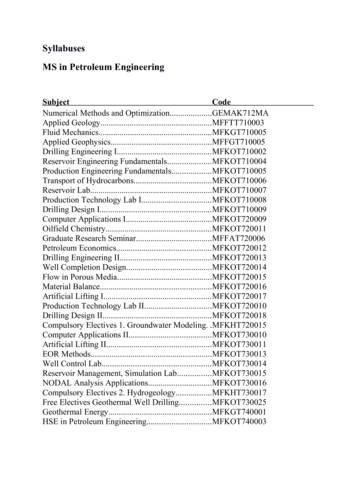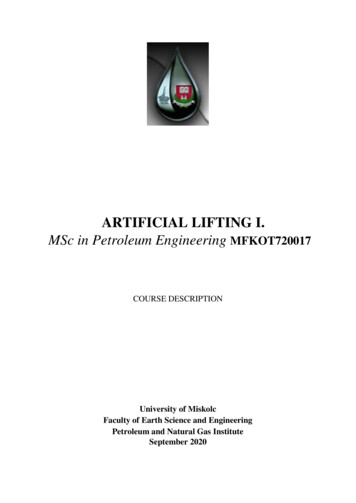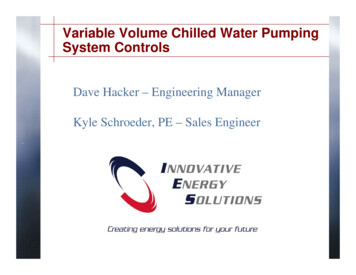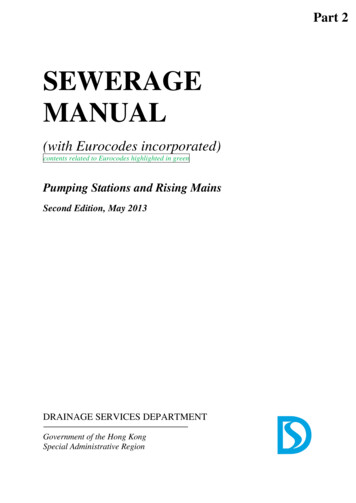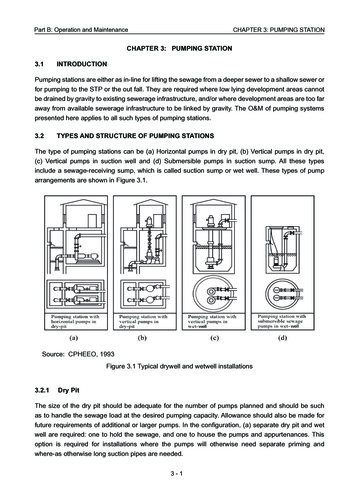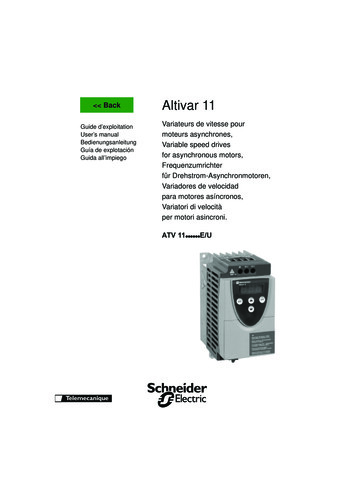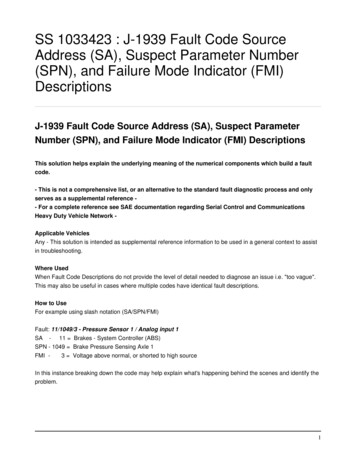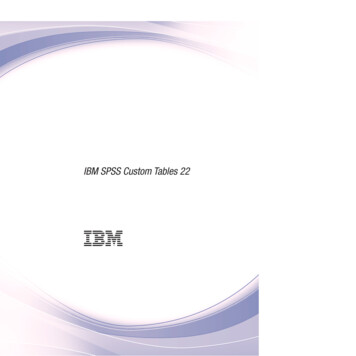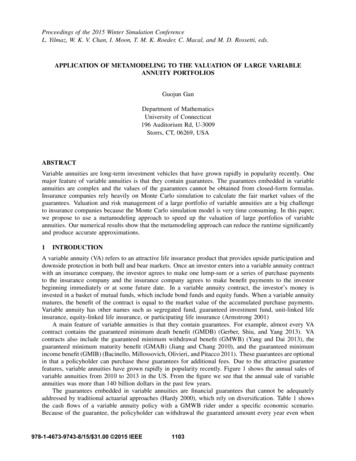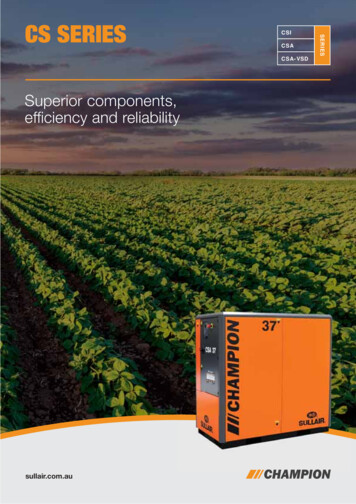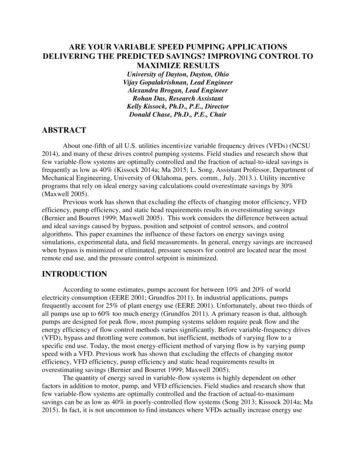
Transcription
ARE YOUR VARIABLE SPEED PUMPING APPLICATIONSDELIVERING THE PREDICTED SAVINGS? IMPROVING CONTROL TOMAXIMIZE RESULTSUniversity of Dayton, Dayton, OhioVijay Gopalakrishnan, Lead EngineerAlexandra Brogan, Lead EngineerRohan Das, Research AssistantKelly Kissock, Ph.D., P.E., DirectorDonald Chase, Ph.D., P.E., ChairABSTRACTAbout one-fifth of all U.S. utilities incentivize variable frequency drives (VFDs) (NCSU2014), and many of these drives control pumping systems. Field studies and research show thatfew variable-flow systems are optimally controlled and the fraction of actual-to-ideal savings isfrequently as low as 40% (Kissock 2014a; Ma 2015; L. Song, Assistant Professor, Department ofMechanical Engineering, University of Oklahoma, pers. comm., July, 2013.). Utility incentiveprograms that rely on ideal energy saving calculations could overestimate savings by 30%(Maxwell 2005).Previous work has shown that excluding the effects of changing motor efficiency, VFDefficiency, pump efficiency, and static head requirements results in overestimating savings(Bernier and Bourret 1999; Maxwell 2005). This work considers the difference between actualand ideal savings caused by bypass, position and setpoint of control sensors, and controlalgorithms. This paper examines the influence of these factors on energy savings usingsimulations, experimental data, and field measurements. In general, energy savings are increasedwhen bypass is minimized or eliminated, pressure sensors for control are located near the mostremote end use, and the pressure control setpoint is minimized.INTRODUCTIONAccording to some estimates, pumps account for between 10% and 20% of worldelectricity consumption (EERE 2001; Grundfos 2011). In industrial applications, pumpsfrequently account for 25% of plant energy use (EERE 2001). Unfortunately, about two thirds ofall pumps use up to 60% too much energy (Grundfos 2011). A primary reason is that, althoughpumps are designed for peak flow, most pumping systems seldom require peak flow and theenergy efficiency of flow control methods varies significantly. Before variable-frequency drives(VFD), bypass and throttling were common, but inefficient, methods of varying flow to aspecific end use. Today, the most energy-efficient method of varying flow is by varying pumpspeed with a VFD. Previous work has shown that excluding the effects of changing motorefficiency, VFD efficiency, pump efficiency and static head requirements results inoverestimating savings (Bernier and Bourret 1999; Maxwell 2005).The quantity of energy saved in variable-flow systems is highly dependent on otherfactors in addition to motor, pump, and VFD efficiencies. Field studies and research show thatfew variable-flow systems are optimally controlled and the fraction of actual-to-maximumsavings can be as low as 40% in poorly-controlled flow systems (Song 2013; Kissock 2014a; Ma2015). In fact, it is not uncommon to find instances where VFDs actually increase energy use
when VFD efficiency losses are greater than pump power savings (Seryak, John. 2014. "Fan andPump System Low-Cost/No-Cost Energy Efficiency Opportunity Identification”. Triple PointEnergy Saving Seminar, Chillicothe, OH, April 10, 2014.).This work considers the difference between actual and ideal savings caused by bypass,position and setpoint of control sensors, and control algorithms. The paper begins by defining“ideal” flow control as the most energy-efficient type of flow control, and compares pump powerfrom reducing flow by throttling to the ideal case. Since some minimum flow is required in mostpumping systems, the effect of bypass flow on pumping energy use is considered. The controlvariable for most variable flow pumping systems is pressure; hence, the effect of the location andsetpoint value of pressure sensors on pump power is considered. Finally, a case study ispresented which demonstrates how pumping energy can be reduced through application of theseideas.IDEAL FLOW CONTROLIn order to consider the effect of bypass and control on pumping system energy use, it isuseful to define the maximum savings that can be expected from reducing flow. Figure 1 showstwo operating points of a pumping system. Point 1 represents the pump operating at full flow.Point 2V is the operating point if pump speed is slowed by an optimally-controlled VFD. Point 2Vlies on a system curve in which dh (the pressure head) approaches zero as volume flow rateapproaches zero and pump head varies with the square of volume flow rate. This ideal caserepresents the minimum pumping power that can be expected when flow is reduced from V̇1 toV̇2 . The reduction in pump power is also defined by the pump affinity law shown in Equation 1,where W is fluid work and V̇ is volume flow rate at respective operating points.3𝑉̇2𝑊2𝑉 𝑊1 ( )1𝑉1̇Figure 1. The ideal system curve approaches zero head at zero flow.Few actual pumping systems achieve the power reduction defined by the pump affinitylaw because of throttling, minimum flow constraints, static head requirements due to changes in
elevation, velocity and pressure between the inlet and outlet of the piping system, and controllosses. In the following sections, these deviations from the ideal case are investigated.THROTTLED FLOW CONTOLOne of the most common methods of varying flow is to throttle flow by partially closinga valve in the piping system. In this section, we compare pump power from reducing flow bythrottling to reducing flow by slowing the pump with a VFD. The University of DaytonHydraulics Lab (UDHL) is equipped with two pumps, a VFD, a parallel piping network withfour branches, pressure sensors, and flow meters. In Figure 2, Point 1 is the operating point withthe pump at full flow. Point 2T is the operating point when flow was throttled to volume flowrate, V̇2 . Point 2V is the operating point when pump speed was slowed by a VFD to volume flowrate, V̇2 . Pump power is proportional to the product of head and flow, which is represented by therectangular area defined by each operating point. The data show that when flow was controlledby throttling at Point 2T, the pump ran at 1,800 rpm and consumed 8.5 kW. When flow wascontrolled by the VFD at Point 2V, the pump ran at 1,180 rpm and consumed 3.25 kW; pumppower decreased by 62%. Clearly, reducing flow with a VFD is more energy-efficient thanthrottling flow.Figure 2. Measured energy penalty due to throttled flow.In pumping systems the power transmitted to the fluid, Wfluid, is given by Equation 2where dh is the pressure head across the pump and V̇ is the volume flow rate.𝑊𝑓𝑙𝑢𝑖𝑑 [𝑘𝑊] At Point 2V, the fluid work was:𝑊𝑓𝑙𝑢𝑖𝑑 [𝑘𝑊] 𝑑ℎ[𝑓𝑡 𝐻2 𝑂 ] 𝑉[𝑔𝑝𝑚]𝑘𝑊 0.746 []3,960 [𝑔𝑝𝑚 𝑓𝑡 𝐻2 𝑂/ℎ𝑝]ℎ𝑝271.6 𝑓𝑡 𝐻2 𝑂 81 𝑔𝑝𝑚0.746 𝑘𝑊 1.09 𝑘𝑊3,960 𝑔𝑝𝑚 𝑓𝑡 𝐻2 𝑂/ℎ𝑝ℎ𝑝However, the electrical power to the pump motor is always greater than fluid work because ofefficiency losses in motor, pump, and VFD. Using the measured power draw and calculated fluidwork, the combined efficiency, ηcombined, is given by Equation 3.
𝜂𝑐𝑜𝑚𝑏𝑖𝑛𝑒𝑑 At Point 2V, the combined efficiency was:𝜂𝑐𝑜𝑚𝑏𝑖𝑛𝑒𝑑 𝑊𝑓𝑙𝑢𝑖𝑑 [𝑘𝑊]𝑃[𝑘𝑊]31.09 𝑘𝑊 100% 34%3.25 𝑘𝑊The combined efficiencies at Points 2T and 2V were 32% and 34%, respectively. These resultsindicate that about 70% of pump power was lost due to inefficiencies in the motor, pump, andVFD.MINIMUM FLOW CONSTRAINTSMost pumping systems require some minimum flow due to constraints such as minimumVFD speed, minimum flow through the pump, or minimum flow through equipment such as achiller evaporator. Hence, a bypass is needed to provide a path for minimum flow when end usesreduce flow below this minimum. In the ideal case, no bypass flow is permitted when the enduses require more than minimum flow. Flow in excess of the minimum required flow increasespumping power and wastes energy.Ideal Bypass Flow Control“Primary-only” pumping systems use a single pump (or set of pumps in parallel) to movefluid through a chiller and to end uses. In primary-only pumping systems, best practice to meet aminimum flow constraint is to add bypass piping with an actuated 2-way valve to the pipingsystem (Avery 2009). The bypass valve is closed when the end uses require more than minimumflow. The valve opens to allow minimum flow based on a flow meter as shown in Figure 3(Taylor 2012) or based on the pressure difference through the chiller as shown in Figure 4 (J.Fauber, Senior Mechanical Engineer, Heapy Engineering, E, pers. comm., May 2015).Figure 3. Primary-only system with 2-waybypass controlled by flow meter.Figure 4. Primary-only system with 2-waybypass controlled by differential pressure.Another way to guarantee minimum flow through chillers is by dedicating “primary”pumps to move water through the chiller(s) and “secondary” pumps to move water to end uses.In primary-secondary systems, constant-speed primary pumps provide minimum flow to thechiller(s) which eliminates the need for a bypass valve as shown in Figure 5.
dPVFDSecondaryPumpConstant SpeedPrimary PumpChilledWater toEnd UsesChillerFigure 5. Primary-secondary system eliminates the need for a bypass valveExcess Bypass FlowThe effect of excess bypass flow on energy savings in variable-flow pumping systemswas experimentally measured in the UDHL. In this experiment, flow through “the process” enduse was 81 gpm with the manually-controlled bypass valve closed. Next, flow through “theprocess” end use was maintained at 81 gpm with the bypass valve about 50% open. Figure 6shows that with the bypass valve closed, the VFD ran at 1,180 rpm, total flow was 81 gpm, andthe operating point is 2VC. With the bypass valve 50% open, the VFD ran at 1,212 rpm, total flowwas 134 gpm, and the operating point shifted to 2VO. Since flow through the process end use wasmaintained at 81 gpm, 53 gpm traveled through the bypass loop. In this case, pump powerincreased from 3.25 kW to 4.12 kW or about 27%. When the manually-controlled bypass valvewas fully open, pump power increased by 54%. This indicates that if the effect of excess bypassflow is neglected in savings calculations, those calculations will significantly overestimatesavings. These results also suggest that savings can be significantly increased by minimizingexcess bypass.Figure 6. Measured energy penalty associated with bypass 50% openThree common piping systems that result in excess bypass flow are shown below. Thefirst is a 3-way valve at one or more end uses as shown Figure 7. The 3-way valve(s) alwaysallows some bypass flow, thus wasting pumping energy.
Figure 7. 3-way bypass valve at one end use.Another piping system that allows excess bypass flow uses a manually-controlled bypassvalve as shown in Figure 8. Manually-controlled valves are always at least partially open andhence allow bypass flow even when no bypass is required. The recommended commissioningpractice in a system with a manually-controlled bypass valve is to close all end use loads andthrottle to allow minimum required flow (J. Kelley, Energy Engineer, Plug Smart, LLC, E, pers.comm., February 2015.). However, when end use valves close, flow through the bypass valveincreases due to rebalancing of flow, allowing more than minimum flow through bypass.Rebalancing of flow is shown experimentally by the difference in flows V̇2𝑇𝑂 and V̇2𝑉𝑂 in Figure6. In industrial systems, manually-controlled bypass valves are often neglected after installationand allow unmonitored excess bypass flow.Figure 8. Manually-controlled bypass valve.A third common piping system that allows excess flow uses an automatic flow-limiter onthe bypass pipe as shown in Figure 9. Automatic flow-limiters are better than manuallycontrolled valves since they prevent rebalancing of flow. However, they still allow a fixedamount of bypass flow when no bypass is required, resulting in wasted pumping energy.Figure 9. Automatic flow-limiter bypass valve.
PUMP SPEED CONTROLFixed Pressure Setpoint ControlAutomatically-controlled VFDs modulate pump speed based on data from a controlvariable; the most common control variable is pressure. The setpoint pressure determines the yintercept of the system curve; hence, a high pressure setpoint increases pump power at all flows.This concept is demonstrated in Figure 10. The rectangle defined by Point 2V80 represents pumppower when the pressure setpoint value is 80 ft. H2O. The rectangle defined by Point 2V40represents pump power when the pressure setpoint value is 40 ft. H2O. The difference in the sizeof the rectangles represents the additional energy associated with setting the dP at 80 ft. H2Ocompared to setting it at 40 ft. H2O.Figure 10. Additional energy associated with a higher dP setpoint is represented by the difference in the rectangles.The setpoint pressure must be large enough to push fluid through the end uses anddepends on the location of the sensor in relation to the pump and end uses. The influence ofsensor location on pressure setpoint is demonstrated by considering four common pumpingsystems.Figure 11 shows a closed-loop chilled water system with a sensor located at the pumpoutlet measuring differential pressure between the supply and return headers. At this location, thepressure setpoint has to be high enough to push fluid from point 2 through the supply header,through the most remote end use, and back to point 3 through the return header. If the differentialpressure sensor were located near the most remote end use, the pressure setpoint would onlyhave to be high enough to push fluid through the most remote end use. Thus, controlling theVFD based on the differential pressure near the most remote end use results in a lower setpointpressure and reduced energy use. Locating a differential pressure sensor at the most remotelocation is recommended by ASHRAE Standard 90.1-2010 (ANSI/ASHRAE Standard 90.12010).Another way to consider pumping energy use is to characterize energy savings in termsof flow reductions and head reductions. In Figure 11, from reference points 1-to-2 and 3-to-1,energy savings would be realized from flow and head reductions. From reference points 2-to-3,energy savings would only be realized from flow reduction in end uses. Thus, the total pressuredrop across the pump would decrease only slightly due to reduced flow through the chiller.
Figure 11. Closed-loop chilled water system with differential pressure sensor at the discharge of the pump.Figure 12 shows a closed-loop chilled water system with a sensor measuring pressure atthe discharge of the pump. At this location, the pressure setpoint has to be high enough to pushfluid from point 2, through the end uses, through the chiller, and back to the pump at point 2.Thus, controlling the VFD based on pump discharge pressure results in an even higher setpointthan in Figure 11, and increased energy use.As before, pumping energy use through Figure 12 can also be described in terms of flowreductions and head reductions. From reference points 1-to-2, energy savings would be realizedfrom flow and head reductions. From reference points 2-to-1, energy savings would only berealized from flow reduction in end uses. Thus, the total pressure drop across the pump wouldremain nearly constant even as flow is reduced, and energy savings from pressure reduction areminimal.Figure 12. Closed-loop chilled water system with single pressure sensor at the discharge of the pump.Figure 13 shows an open-loop cooled-water system with a sensor measuring pressure atthe discharge of the pump. At this location, the pressure setpoint has to be high enough to pushfluid from point 2 through the end uses and into the open tank. Moreover, additional pressurehead is required to lift the fluid from 3-to-2. Thus, controlling the VFD based on pump dischargepressure results in a high pressure setpoint.As before, from reference points 1-to-2 and 3-to-1, energy savings would be realizedfrom flow and head reductions. From reference points 2-to-3 and to lift the fluid through theelevation gain, energy savings would only be realized from flow reduction.
Figure 13. Open-loop cooled-water system with single pressure at the discharge of the pump.Figure 14 shows an open-loop cooled-water system with a sensor measuring pressure atthe discharge of the pump. At this location, the pressure setpoint has to be high enough to pushfluid from point 2 through the entire supply header and through the most remote end use. If thepressure sensor were located near the most remote end use, the pressure setpoint would onlyhave to be high enough to push fluid through the most remote end use. Thus, controlling theVFD based on the pressure near the most remote end use results in a lower setpoint pressure andreduced energy use.As before, from reference points 1-to-2 and 4-to-1, energy savings would be realizedfrom flow and head reductions. From reference points 2-to-3 and to lift the fluid through theelevation gain, energy savings would only be realized from flow reduction.Figure 14. Open-loop system with single pressure sensor at the discharge of the pump.Resetting Pressure Setpoint Based on Valve PositionAs demonstrated above, a high pressure setpoint reduces energy savings when reducingflow. In fixed pressure setpoint control, the pressure setpoint must be high enough to maintainflow at peak conditions. However, many pumping systems seldom require peak flow. In thesecases, the pressure setpoint can be dynamically reduced to save pumping energy. In valveposition control, the pressure setpoint, and hence VFD speed, decreases until at least one valve isalmost fully open. Thus, valve position control supplies the required flow, at minimum pressure,without starving any end uses. The effect is to approach zero head at zero flow and approach theideal pumping system shown in Figure 1.Valve position control is especially effective in parallel-flow piping systems wherepressure based control may starve some end uses. For example, if the parallel-flow piping systemshown in Figure 15 used fixed setpoint pressure control, locating the differential pressure sensor
in circuit A may starve end uses in the circuit B if circuit B requires more flow and pressure thancircuit A. Valve position control is less effective on systems with multiple end uses of differentsizes. Moreover, valve position control does not set the lower limit on VFD speed; this is doneelsewhere in the control algorithm.Figure 15. Parallel-flow pumping system.CASE STUDYThe following case study demonstrates energy saving potential from minimizing bypassflow and pressure control losses. The variable-flow HVAC chilled water system shown inFigure 16 employs best practice by locating a differential pressure sensor near the most remoteend use. In addition, the pressure sensors across the chiller evaporators can be used to measureflow through the evaporators to ensure minimum flow. The use of reverse return balancesunregulated flow through the air handlers (Taylor 2002). The use of a three-way bypass valve atAHU 1 is not a recommended practice because some flow is always being pumped through thebypass.Figure 16. Chilled water pumping system in case study.Despite the existence of VFDs and well-located pressure sensors, data from the controlsystem indicate non-optimal control. Figure 17 shows measured five-minute VFD speed versusbuilding differential pressure (dP) data from April 2014 to November 2014 when only Pump 1
was operating. Figure 18 shows measured five-minute VFD speed versus chiller evaporator dPdata from April 2014 to November 2014 when only Pump 1 was operating. In a properlycontrolled system, the VFD should vary speed to maintain a constant building dP. However, thedata show that the building dP varies between 1 psi and 8 psi. In addition, in a properlycontrolled system, the VFD speed and building dP should be highly correlated. However,statistical analysis shows an R2 value of 0.02 between VFD speed and building dP. In fact, Pump1 operates at 70% for 55% of the time. According to the chiller specification sheets, the chillerevaporator dP must be between 1.4 psi and 6.4 psi. However, it maintains an average chillerevaporator dP of 6 psi and often exceeds the limit of 6.4 psi. All this indicates very poor control.1001009080807070VFD Speed (%)VSD Speed (%)Upper limit of chiller evaporator dP, 6.4 psi90Building differential pressure varies from 1 psi to 7.5 psi.606050504040303020201010002468Building dP (psi)10001234567Evaporator dP (psi)Figure 17. Building dP vs. VFD Speed.Figure 18. Chiller Evaporator dP vs. VFD Speed.Time series data offers more insight into the control problems. As seen in Figure 19, theVFD operated at an average speed of 70% on Saturday, May 10, when the average outdoor airtemperature was 65.5 F, the average relative humidity was 70% and occupancy and internalloads were small. In Figure 20, the VFD operated at an average speed of 64% on Thursday, July10, when the average outdoor air temperature was 70.7 F1 and the average relative humidity was66%2 and occupancy and internal loads were high. If properly controlled, the VFD speed wouldbe higher on a hotter, wetter day with higher occupancy and internal loads. However, theopposite is true. The VFD speed is stuck at 70% on May 10 and drops to 30% on July 10. Thisindicates inefficient control.Figure 19. Trend data on Saturday, May 10, 2014.Figure 20. Trend data on Thursday, July 10, 2014.Average daily temperatures were taken from Kissock’s Average Daily Temperature eather/2Relative humidity taken from Weather Underground: http://www.wunderground.com18
The original control algorithm executes the following steps:1.2.3.4.Chiller 1 and Pump 1 turn on when the outdoor air temperature is above 65 F. Foroutdoor air temperatures between 55 F and 65 F, economizers on the air handling units(AHU) are able to meet the cooling load.Differential pressure is read across the building and Chiller 1 evaporator: The chiller evaporator dP must be maintained between 1.5 psi and 6.4 psi. If it ishigher or lower, the VFD ramps up or down to maintain the upper and lowerbounds. The building dP setpoint is 10 psi. The VFD simultaneously ramps up or down tomaintain 10 psi across the building.If the building dP drops below 2.3 psi for 30 minutes, pump 2 turns on to increasebuilding pressure.If the chilled water supply temperature is greater than 48 F, Chiller 2 comes on toprovide more cooling capacity to the building.Because of the 6.4 psi upper bound on the chiller evaporator dP, the VFD is alwayshunting for, but never reaches, the building dP setpoint of 10 psi. To improve energy-efficiency,the building dP setpoint should be reset to 2.3 psi. According to maintenance personnel this issufficient to supply all air handlers with adequate flow. In addition, it guarantees a minimum of1.4 psi pressure drop, and minimum flow, through the evaporator. This change will stop the VFDfrom hunting for a set-point it can never attain. Instead, the VFD speed will vary with thethermal building load; resulting in better controlled and more energy-efficient pumping. Usingthe pump affinity law with an exponent of 2.5, the estimated annual savings from implementingthe reduced building dP setpoint are 47% of chilled water pumping energy use.After this change is successfully implemented, we will recommend replacing the 3-waybypass valve with an actuated 2-way bypass valve controlled to provide a minimum pressuredrop, and hence flow, across the chiller evaporator. Next, we will recommend resetting thebuilding dP setpoint based on valve position. We will begin implementing these changes aftersufficient baseline data is collected so energy savings can be measured.CONCLUSIONSThis paper describes several best practices for controlling variable-flow pumpingsystems. As variable-flow pumping systems become more common, adhering to these bestpractices are important in order to maximize energy savings. In our experience, many variableflow pumping systems are not optimally controlled, so the potential for savings is great.To maximize energy savings in variable-flow pumping systems, bypass flow should beminimized or eliminated. Best practice to eliminate excess bypass flow is to employ an actuatedtwo-way bypass valve or primary-secondary pumping. If the effect of excess bypass is neglected,savings calculations will significantly overestimate savings.Best practice in controlling VFD speed is locating a differential pressure sensor near themost remote end use in the system. To increase energy savings, the dP setpoint should be as lowas possible. Further, valve position can be used to reset the pressure setpoint downward to allowstatic head to approach zero and maximize energy savings.
ACKNOWLEDGMENTSWe are grateful for support for this work from the U.S. Department of Energy throughthe Industrial Assessment Center program and through an Excellence in Applied EnergyEngineering Research grant. We are very grateful to Steve Kendig and John Brammer forproviding access to and information about the chilled water pumping system and for helping usdevelop an improved algorithm. We are also grateful to Bernard Glascoe for assisting us in theUDHL. We are also very grateful to Jeremy Fauber for technical support and feedback. Finally,we are grateful to the IAC students and staff upon whose work this effort is built.REFERENCESANSI/ASHRAE Standard 90.1-2010, Energy Standard for Buildings Except Low-RiseResidential BuildingsAvery, Gil and Rishel, James B. 2009. "Case Against Balancing Valves." ASHRAE Journal 2629. ASHRAE, July.Bernier and Bourret, 1999, “Pumping Energy and Variable Frequency Drives”, ASHRAEJournal, December.EERE (Energy Efficiency and Renewable Energy). 2001. “Pump Life Cycle Costs: A Guide toLCC Analysis for Pumping Systems.” U.S. Department of ech assistance/pdfs/pumplcc 1001.pdfGrundfos Management. 2011. “All You Need to Know About Pumps and mps-energy/energy-and-pump-factsKissock, J. 2014a. Energy Efficient Buildings: Duct System Design, EB/Energy%20Efficient%20Buildings 1.htmMa, Y., Turker, A., Kissock, J. 2015. “Energy Efficient Static Pressure Reset in VAV Systems.”2015 ASHRAE Winter Conference, Chicago: ASHRAE.Maxwell, Jonathan. 2005. “How to Avoid Overestimating Variable Speed Drive Savings.”NCSU (North Carolina State University). 2014. DSIRE (Database of State Incentives forRenewables & Energy Efficiency). www.dsireusa.orgTaylor, S., Stein, J. 2002. “Balancing Variable Flow Hydronic Systems.” ASHRAE Journal,October.Taylor, S. 2012. “Optimizing Design & Control of Chilled Water Plants, Part 5: OptimizedControl Sequences.” ASHRAE Journal, June.
when bypass is minimized or eliminated, pressure sensors for control are located near the most remote end use, and the pressure control setpoint is minimized. INTRODUCTION According to some estimates, pumps account for between 10% and 20% of world electricity consumption (EERE 2001; Grundfos 2011). In industrial applications, pumps
